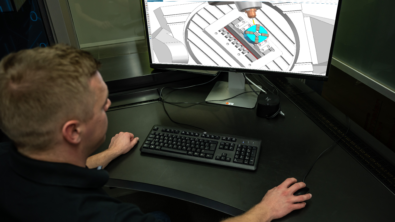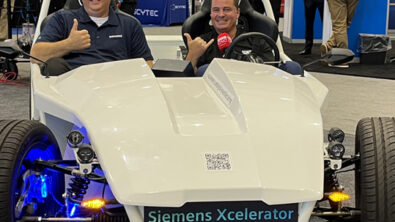Additive Manufacturing and Machining – The integrated Siemens process chain in practice.

Siemens customer Hoedtke GmbH & Co. KG is one of the first manufacturing companies using an industry-standard Directed Energy Deposition (DED) overall solution — from the CAD/CAE/CAM process (with the Siemens NX software suite) through to the printing and machining processes performed on a high-performance machine equipped with SINUMERIK 840D sl.
The video was narrated by representatives from Hoedtke GmbH & Co KG.
Video transcript:
At the end of the 1970s we became aware of the laser which had so far not yet been developed in the metal working industry. Laser cutting was the first innovative technology. Further we used the welding process to perform hardening and heat treatment applications. It can now be said that the additive manufacturing of components comes next. Shooting a metal powder jet three dimensionally in space into the focal point of the laser beam in order to melt the metal powder brains. In general, the laser cladding process for additive manufacturing provides the benefit that we can apply a huge amount of material within a very short time. This allows us to quickly produce components three dimensionally thus achieving superior productivity. This concept is fascinating as we use a coarse additive manufacturing process and the accuracy is ensured by a milling application. This hybrid manufacturing process is ideal for us. The five-axis application allows us to process the work pieces all round. In general we start with a 3D computer-aided design (CAD) model. In this context, it is favorable to use a software solution from the design phase to programming, through to production. Only with Siemens NX are we able to prepare the data accordingly for the additive and ablative processes. The software we are using is completely based on NX — NX CAD, NX CAM, and NX Additive. Software simulation is a key factor because every minor shock on the spindle or laser-head would cause enormous damage.
The customer requests a component. On the basis of the customer data we design a customized model using NX CAD. Then we process this model via the NX CAM program, define the laser and milling operations and transfer the program to the machine. The SINUMERIK 840D sl can access the server which means that as soon as the post program is ready, the machine can load the program. In contrast to the processes supplied by other machine manufacturers, this is relatively simple. The SINUMERIK operator interface has a very simple design; you can directly see what you are doing. We had a one week training period which was sufficient to get familiarized with SINUMERIK.
We tried to implement complicated applications and make the process fit for the industry. This is a topic where we closely cooperate with Siemens. We are closely cooperating in the field of development, technologies, and applications. In many cases, we receive support in the short term. Some topics can be quickly clarified in a personal conversation. Last, but not least, we have the possibility to discuss improvements on the real work piece, and jointly solve problems, which will help us to further advance the technology. We have a dream that we want to realize little by little, to proceed fast from a virtual model easily to the production of 3D contours on the machine. This is only possible when using excellent software and data with perimeters that fit for additive manufacturing processes. And, this is exactly our topic. We aim at developing these parameters in cooperation with a strong partner who is much larger than our company, takes us seriously, and who integrates our ideas and philosophy into the software. We can achieve this in cooperation with Siemens – the combination of our skills with the skills of Siemens.
Watch this video to learn more about the Hoedtke GmbH & Co KG story.


